How would you cook this fish?
Threadfin Trevally, a.k.a. African Pompano
Fish Choices
Back in the Bay Area, we always went to one fishmonger, Pat from Mission Fresh Fish who would supply us with the freshest wild salmon (from which we made broiled salmon collar, lomi lomi salmon, and salmon cakes). We trusted him to give us the freshest fish, and even a recipe or two for fish we didn’t know how to cook. Luckily for us here in Kuching, the fishmongers section at our local wet market has a lot of choices for fresh fish:
Fish Vendors at Stutong Market
The array of fresh seafood products here is dizzying. You don’t see any salmon or tuna here but you can find eel, shark, squid, and many others besides the many locally raised or caught fishes. I’m just amazed at just how much fish there is to be had here. There’s always something new to be found.
At the wet market, we patronize one fishmonger who we trust to give us the freshest catch. Usually we get some mackerel from her, but this past weekend she had something we hadn’t seen before – the above fish. Annie didn’t know what it was but I took a look at its distinctive shape – the thin body, arched lateral line and smooth, silvery skin, and immediately thought “papio”. (Papio, is what Hawaiians call the Bluefin Trevally, and it is one of the prized fishes for anglers because of its fun fight when hooked and good eats when cooked.)
This particular fish at the market, however, had trailing filaments on its upper and lower fins, thus marking it as a Threadfin Trevally, a.k.a African Pompano a cousin of the papio. The fish was about 1.5 kg and cost 20 ringgit (about $6.50 USD) to take home, cleaned. Not a bad deal at all!
Cooking Choices
The fishmonger suggested we steam the fish but my first inclination was to pan-fry it in butter like I would for a papio. Annie was cooking up a storm (as usual) and so couldn’t use the stove to either fry or steam. She suggested we wrap it in foil and bake it in the oven “en papillote”-style. Brilliant!
To cook something “en papillote” or “in parchment” is to wrap food up in a packet and steam-cook it in its own liquids. It’s traditionally done with parchment paper but you can also do it with banana leaves (see our Otak-Otak recipe) or aluminum foil. It’s also pretty easy to put together, which is always a plus for someone like me who isn’t so skilled in the kitchen.
Papio en Papillote Recipe
Prep time: 15 min mins Cook time: 50 min
Ingredients:
1, 1.5 kg fish (you can substitute with smaller fishes or fillets)
8 Tbsp soy sauce
4 Tbsp sake
3 Tbsp sugar
4 Tbsp finely grated ginger
Method:
Clean and wash the fish. Preheat the oven to 350*F / 180*C.
Finely grate the ginger (I used the ceramic garlic grater we got at the Fabulous Food Festival a while back). Mix together with the soy sauce, sake and sugar in a small pan and bring to a simmer. Stir to combine until the sugar is dissolved. Remove from heat. (If you like, you can strain out the ginger solids, but I left them in.)
Line a baking pan with enough foil to completely wrap the fish. Place the fish in the pan, then pour the marinade inside and outside the fish. Seal the foil and crimp the edges to prevent steam from escaping.
Preparing the papio for baking en papillote
Place the pan in the oven and bake for 30 minutes. Check for doneness by poking it with a fork to see if it flakes. (Our fish wasn’t done by then so we put it back in for another 20 minutes.)
Out of the Oven
The fish is done when it flakes off at the thickest part of the fish.
This fish has firm, white flesh that is not oily. There were few bones – mostly large ones in the usual places – and even the skin was soft enough to eat. The meat’s flavor was mild, and it picked up the soy, sake and ginger flavors nicely. Best of all, cleanup was a snap!
I do hope we see this fish at the fishmonger’s again.
Now tell us, how would you cook this fish? Leave a comment below!
Aloha, Nate
Other fish en papillote recipes by: My Cooking Hut, Wholesome Cook, and Kopiaste
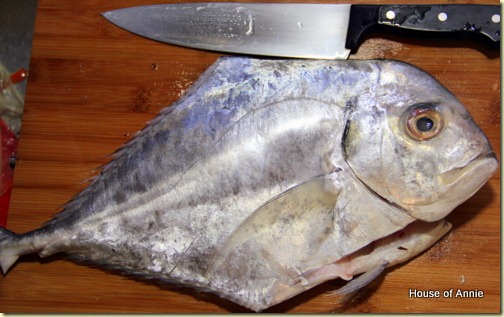
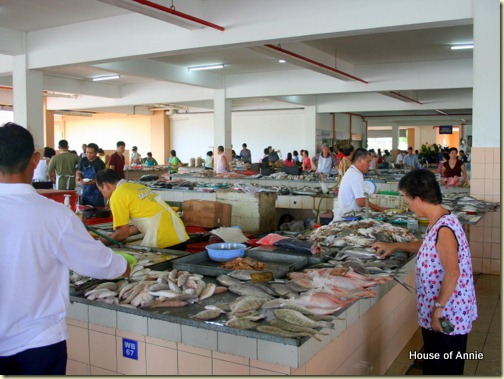
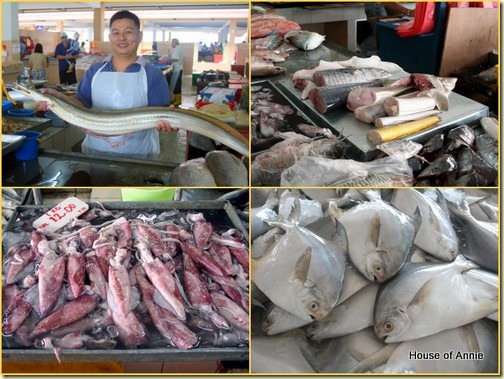
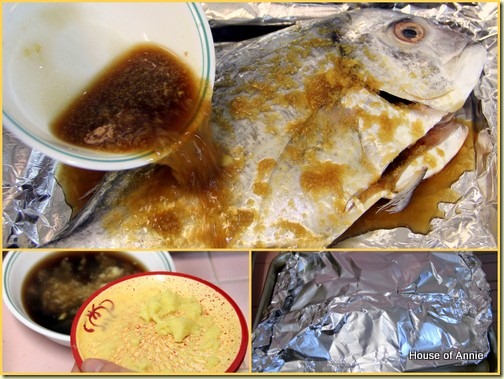
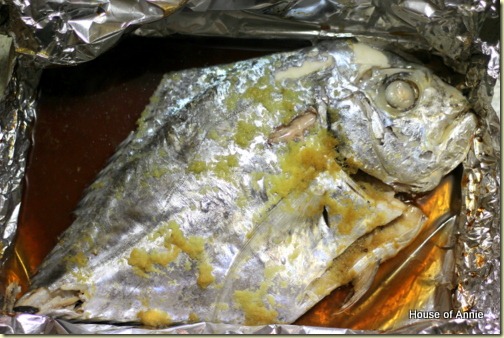
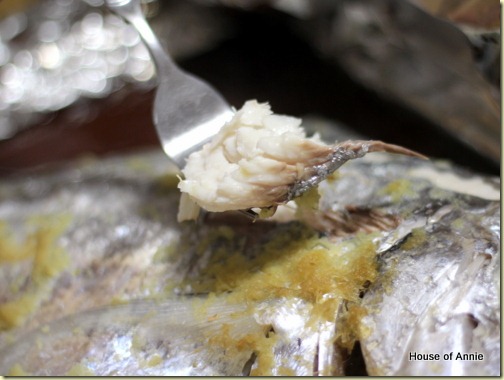
Well, Nate, you stole my favorite method for cooking fish I’m unfamiliar with but it would have been solar cooked — and, maybe, that’s enough of a difference. Wrapped in chard in another favorite, but that’s still en papillote; right? Well, shove that little lady out of the way and saute it in butter. This recipe sounds delicious. Thanks for sharing.
Sharlene
Can you get your solar oven up to 350*F?
Gosh, that looks incredible. I have not had fresh fish like that in ages. I’ve only had fish baked en papillote once in my life. I need to try it more often– so simple and delicious!
Dear Nate,
Love your photos of the wet markets. These are the places that I truly miss and I always try to go to these markets just to eat at the food stalls.
The one fish that I truly miss is the pomfret. They look so fresh and I think they would be even more expensive in Malaysia than here. We only get the frozen ones and they usually come from Thailand and are like the cheapest fish around A$5 per kg.
Chopinand,
the food stalls at another wet market here in Kuching (at 3rd Mile) do very brisk business at night.
We used to eat pomfret a lot, because it’s got really nice flesh and few bones. But it is overfished here in Malaysia so we have chosen to abstain from pomfret and try to eat more sustainably.